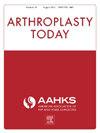Malnutrition is Common in Patients Utilizing Glucagon-Like Peptide-1 Agonists Prior to Total Joint Arthroplasty
IF 2.1
Q3 ORTHOPEDICS
引用次数: 0
Abstract
Background
The rising prevalence of obesity and the increased use of glucagon-like-peptide-1 (GLP-1) receptor agonists for weight loss and diabetes has led to more patients qualifying for elective total joint arthroplasty (TJA). While these medications promote weight reduction, they may predispose patients to nutritional deficiencies. This study aims to evaluate the preoperative nutritional status of GLP-1 users undergoing TJA compared to nonusers.
Methods
A retrospective chart review was conducted at a high-volume center on patients who underwent elective primary TJA between January 1 and May 1, 2025. Patients were included if they had complete preoperative nutritional labs. Nutritional markers included hemoglobin, albumin, total protein, prealbumin, calcium, alkaline phosphatase, and 25-hydroxy vitamin D. Malnutrition was defined as ≥1 laboratory deficiency; severe malnutrition as ≥2 deficiencies. GLP-1 use, indication, and duration were recorded. Statistical analyses included t-tests, chi-square tests, and odds ratio calculations.
Results
A total of 165 patients met inclusion criteria, with 29 (17.6%) actively using GLP-1 receptor agonists. The cohorts were matched for comorbidities. GLP-1 users had higher rates of malnutrition (38% vs 8.8%, P < .001; odds ratio = 6.2), severe malnutrition (17.2% vs 2.9%, P = .009; odds ratio = 6.88), and lower albumin (P < .001), prealbumin (P = .003), and total protein (P = .024) levels compared to controls.
Conclusions
GLP-1 agonist use is associated with significantly higher rates of preoperative nutritional deficiencies in patients undergoing elective TJA. Given the high risk of malnutrition in this growing patient population, targeted nutritional screening and optimization should be considered standard practice in the preoperative evaluation of GLP-1 users.
营养不良在全关节置换术前使用胰高血糖素样肽-1激动剂的患者中很常见
背景:肥胖患病率的上升和胰高血糖素样肽-1 (GLP-1)受体激动剂用于减肥和糖尿病的增加,导致更多的患者符合选择性全关节置换术(TJA)的条件。虽然这些药物有助于减肥,但它们可能使患者易患营养缺乏。本研究旨在评估GLP-1服用者术前与非服用者术前的营养状况。方法回顾性分析某大容量中心于2025年1月1日至5月1日期间接受选择性原发性TJA治疗的患者。如果患者有完整的术前营养检查,则纳入研究。营养指标包括血红蛋白、白蛋白、总蛋白、前白蛋白、钙、碱性磷酸酶和25-羟基维生素d。营养不良定义为≥1实验室缺乏;严重营养不良≥2个缺陷。记录GLP-1的使用、适应症和持续时间。统计分析包括t检验、卡方检验和比值比计算。结果165例患者符合纳入标准,其中29例(17.6%)患者积极使用GLP-1受体激动剂。根据合并症对队列进行匹配。GLP-1使用者的营养不良发生率较高(38% vs 8.8%, P < 0.001;比值比= 6.2),严重营养不良(17.2% vs 2.9%, P = 0.009;比值比= 6.88),白蛋白(P < 0.001)、前白蛋白(P = 0.003)和总蛋白(P = 0.024)水平较对照组低。结论:glp -1激动剂的使用与选择性TJA患者术前营养缺乏率显著升高相关。鉴于这一不断增长的患者群体中营养不良的高风险,有针对性的营养筛查和优化应被视为GLP-1使用者术前评估的标准做法。
本文章由计算机程序翻译,如有差异,请以英文原文为准。
求助全文
约1分钟内获得全文
求助全文
来源期刊

Arthroplasty Today
Medicine-Surgery
CiteScore
2.90
自引率
0.00%
发文量
258
审稿时长
40 weeks
期刊介绍:
Arthroplasty Today is a companion journal to the Journal of Arthroplasty. The journal Arthroplasty Today brings together the clinical and scientific foundations for joint replacement of the hip and knee in an open-access, online format. Arthroplasty Today solicits manuscripts of the highest quality from all areas of scientific endeavor that relate to joint replacement or the treatment of its complications, including those dealing with patient outcomes, economic and policy issues, prosthetic design, biomechanics, biomaterials, and biologic response to arthroplasty. The journal focuses on case reports. It is the purpose of Arthroplasty Today to present material to practicing orthopaedic surgeons that will keep them abreast of developments in the field, prove useful in the care of patients, and aid in understanding the scientific foundation of this subspecialty area of joint replacement. The international members of the Editorial Board provide a worldwide perspective for the journal''s area of interest. Their participation ensures that each issue of Arthroplasty Today provides the reader with timely, peer-reviewed articles of the highest quality.
 求助内容:
求助内容: 应助结果提醒方式:
应助结果提醒方式:


